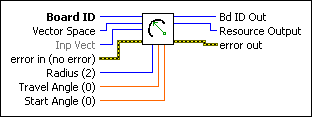Load Circular ArcLoads parameters for making a circular arc move in a 2D or 3D vector space.
| Device Compatibility
|
 |
Board ID is a unique number assigned by Measurement & Automation Explorer (MAX) used to send and receive commands and data to or from a specific NI motion controller. | ||||||
 |
Vector Space is the vector space to control. | ||||||
 |
Inp Vect indicates the source of the data for this VI. Available input vectors include immediate (0xFF), variable (0x01 through 0x78), or indirect variable (0x81 through 0xF8). Refer to Input and Return Vectors for more detailed information.
|
||||||
 |
error in (no error) describes error conditions that occur before this VI runs. The default input of this cluster is no error. If an error already occurred, this VI returns the value of error in in error out. The VI runs normally only if no incoming error exists. Otherwise, the VI passes the error in value to error out. The error in cluster contains the following parameters:
|
||||||
 |
Radius (2) is the arc radius in counts (servo axes) or steps (stepper axes). | ||||||
 |
Travel Angle (0)
is the double precision floating point value, in degrees, of the angle to traverse. A positive Travel Angle defines counterclockwise rotation in the xy plane.
|
||||||
 |
Start Angle (0) is the double precision floating point value, in degrees, of the starting angle of the arc. | ||||||
 |
Bd ID Out is provided for flow control. You can string together NI-Motion VIs by wiring the Bd ID Out terminal of one VI to the Board ID terminal of the next VI. | ||||||
 |
Resource Output is the Axis, Vector Space, ADC, or Encoder you wired into the VI. Use Resource Output to pass the resource to another VI and/or to display information about the device. | ||||||
 |
error out contains error information. If error in indicates an error, error out contains the same error information. Otherwise, it describes the error status that this VI produces.
|
Using This VI
The Load Circular Arc VI defines an arc in the xy plane of a 2D or 3D vector space.
 |
Note Load the velocity and acceleration/deceleration before loading an arc. |
The arc is specified by a radius, starting angle, and travel angle and like all vector space moves, uses the loaded values of vector acceleration and vector velocity to define the motion along the path of the arc. The following figure defines a circular arc.
|
||
| 1 Circular Arc | 3 Starting Position | 5 Radius |
| 2 Travel Angle | 4 Start Angle | 6 Ending Position |
Circular arcs are not limited to ±360°. Moves of over 4,000 circular revolutions in either direction can be started with one call to this VI.
 |
Note If you are doing onboard programming and are using Inp Vect to get the data this VI needs, remember that this VI reads the variables starting at the memory address pointed to by Inp Vect in the following order: Radius, Start Angle, Travel Angle. |
Refer to NI 73xx Arc Angles in Degrees for more information about representing angles numerically.
Remarks
This section includes information about how the behavior of this VI differs among the controllers that support it.
NI 73xx Controller Considerations
The following list includes considerations you must make when you are using this VI with a 73xx motion controller:
- The range for Radius (2) is 2 to 231–1 counts (steps).
- The range for Start Angle (0) is 0 to 359.999313° where angle 0 is along the positive x axis and values increase counterclockwise from the positive x axis in the xy plane.
- The range for Travel Angle (0) is –1,474,560° to +1,474,200° (–4,096 to +4,095 revolutions).
NI SoftMotion Controller Considerations
The following list includes considerations you must make when you are using this VI with the NI SoftMotion Controller:
- The range for Radius (2) is 0 to 231–1 counts (steps).
- The range for Start Angle (0) is 0 to 360° where angle 0 is along the positive x axis and values increase counterclockwise from the positive x axis in the xy plane.
- The range for Travel Angle (0) is the full 64-bit range.







